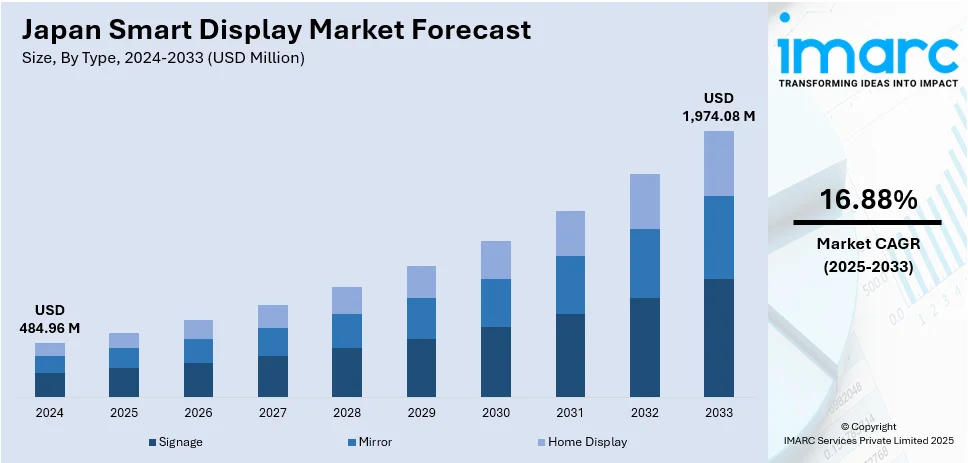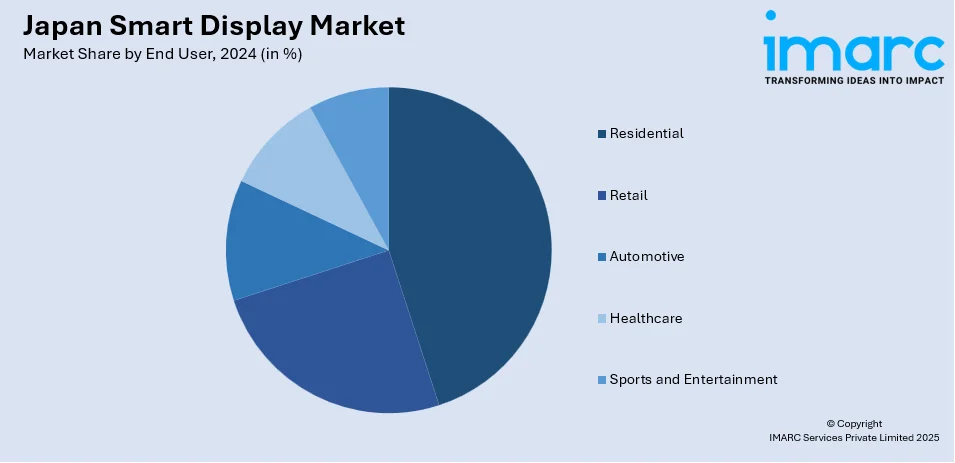
Japan Smart Display Market Size, Share, Trends and Forecast by Type, Display Size, Resolution, End User, and Region, 2025-2033
Japan Smart Display Market Overview:
The Japan smart display market size reached USD 484.96 Million in 2024. Looking forward, IMARC Group expects the market to reach USD 1,974.08 Million by 2033, exhibiting a growth rate (CAGR) of 16.88% during 2025-2033. The market is fueled by rising smart home uptake, an aging population with tech-savvy inclinations, and government backing for digital infrastructure. Additionally, convergence of AI and IoT technologies fits into Japan's "Society 5.0" vision, promoting widespread adoption in both public and residential areas. Moreover, increasing demand for home automation, voice-enabled devices, and remote working solutions are some of the other factors contributing to the Japan smart display market share.
|
Report Attribute
|
Key Statistics
|
|---|---|
|
Base Year
|
2024 |
|
Forecast Years
|
2025-2033
|
|
Historical Years
|
2019-2024
|
| Market Size in 2024 | USD 484.96 Million |
| Market Forecast in 2033 | USD 1,974.08 Million |
| Market Growth Rate 2025-2033 | 16.88% |
Japan Smart Display Market Trends:
Integration of Smart Displays in Japan's Society 5.0 Vision
Japan's vision for "Society 5.0," a notion to build a "super smart society" by merging cyberspace and real space, has played a crucial role in the use of smart displays. The devices, which are a blend of cutting-edge technologies such as artificial intelligence and the Internet of Things, play a central role in achieving this vision. In smart homes, for example, smart displays act as central hubs where users can control lighting, security systems, and appliances via voice commands and touch interfaces. While this integration adds convenience, it also aids the aging population by offering features such as medication reminders and video calls, thus enhancing quality of life. Additionally, in the public arena, smart displays find application in digital signage, presenting real-time updates and interactive services to citizens as well as visitors. The wide-scale adoption of these devices supports Japan's open-minded attitude in integrating technology with everyday life toward building a transparent and streamlined framework for society.

Technological Advancements and Consumer Preferences
The Japan smart display market growth is fueled by evolving technological advancements as well as highly discerning customers. Manufacturers are consistently innovating and adding features like high-quality OLED displays, voice recognition, and AI-powered features to address the changing needs of consumers. For example, the devices can now understand and respond in Japanese and provide localized content like news, weather, and entertainment that appeals to the cultural likes of the people. Besides, the increasing use of remote working and online learning has spurred the uptake of smart displays in home offices and schools, where they enable virtual conferencing and collaborative lessons. With these innovations, challenges persist, such as data privacy concerns and the necessity for smart devices to work together seamlessly. Solving these problems is essential to maintaining consumer confidence and ensuring the continued expansion of Japan's smart display market.
Competitive Landscape and Market Dynamics
Japan's smart display market's competitive landscape is experiencing tremendous changes, with local and foreign companies competing for market share. Traditionally dominated by Japanese brands, the market has witnessed growing competition from Chinese companies such as Hisense, TCL, and Xiaomi, which have started offering high-quality, AI-enabled smart displays at affordable prices. While these companies competing in the budget segment, they are also encroaching into the premium segment, which was traditionally the monopoly of established Japanese and South Korean brands. This transformation is due to their quick embrace of new display technologies and AI features, which improve user experience and content customization. Consequently, Japanese manufacturers are forced to innovate and differentiate their products in order to keep their market share. The synergy between local innovation and international competition is driving the future direction of Japan's smart display market, with a focus on the importance of ongoing technological innovation and competitive market positioning. In October 2023, coinciding with the Highly-Functional Material Week TOKYO, the 33rd FINETECH JAPAN made its return to present the newest developments in OLED, LCD and Micro-LED technologies from 4 to 6 October at Makuhari Messe, Japan, reinforcing its position as the premier venue for leading and emerging display related technology innovations globally. The worldwide display sector is experiencing a transformative period, as innovations and technological advancements change our interaction with digital content. FINETECH JAPAN 2023 had an impressive array of exhibit providers that showcased a preview of the exceptional showcase, featuring industry frontrunners such as Adacotech, LTD., K&D Technology (Hong Kong) Co., DON CO., Limited, Nippon Electric Glass Co., Ltd., and MATSUNAMI GLASS IND. LTD. These pioneers presented their newest innovations and solutions, providing participants a direct view of the recent progress influencing the display sector.
Japan Smart Display Market Segmentation:
IMARC Group provides an analysis of the key trends in each segment of the market, along with forecasts at the country and regional levels for 2025-2033. Our report has categorized the market based on type, display size, resolution, and end user.
Type Insights:
- Signage
- Mirror
- Home Display
The report has provided a detailed breakup and analysis of the market based on the type. This includes signage, mirror, and home display.
Display Size Insights:
- Below 32 Inch
- Between 32 and 52 Inch
- Above 52 Inch
The report has provided a detailed breakup and analysis of the market based on the display size. This includes below 32 inch, between 32 and 52 inch, and above 52 inch.
Resolution Insights:
- UHD
- FHD
- HD
The report has provided a detailed breakup and analysis of the market based on the resolution. This includes UHD, FHD, and HD.
End User Insights:

- Residential
- Retail
- Automotive
- Healthcare
- Sports and Entertainment
The report has provided a detailed breakup and analysis of the market based on the end user. This includes residential, retail, automotive, healthcare, and sports and entertainment.
Regional Insights:
- Kanto Region
- Kansai/Kinki Region
- Central /Chubu Region
- Kyushu-Okinawa Region
- Tohoku Region
- Chugoku Region
- Hokkaido Region
- Shikoku Region
The report has also provided a comprehensive analysis of all the major regional markets, which include Kanto Region, Kansai/Kinki Region, Central/Chubu Region, Kyushu-Okinawa Region, Tohoku Region, Chugoku Region, Hokkaido Region, and Shikoku Region.
Competitive Landscape:
The market research report has also provided a comprehensive analysis of the competitive landscape. Competitive analysis such as market structure, key player positioning, top winning strategies, competitive dashboard, and company evaluation quadrant has been covered in the report. Also, detailed profiles of all major companies have been provided.
Japan Smart Display Market Report Coverage:
| Report Features | Details |
|---|---|
| Base Year of the Analysis | 2024 |
| Historical Period | 2019-2024 |
| Forecast Period | 2025-2033 |
| Units | Million USD |
| Scope of the Report |
Exploration of Historical Trends and Market Outlook, Industry Catalysts and Challenges, Segment-Wise Historical and Future Market Assessment:
|
| Types Covered | Signage, Mirror, Home Display |
| Display Sizes Covered | Below 32 Inch, Between 32 and 52 Inch, Above 52 Inch |
| Resolutions Covered | UHD, FHD, HD |
| End Users Covered | Residential, Retail, Automotive, Healthcare, Sports and Entertainment |
| Regions Covered | Kanto Region, Kansai/Kinki Region, Central/Chubu Region, Kyushu-Okinawa Region, Tohoku Region, Chugoku Region, Hokkaido Region, Shikoku Region |
| Customization Scope | 10% Free Customization |
| Post-Sale Analyst Support | 10-12 Weeks |
| Delivery Format | PDF and Excel through Email (We can also provide the editable version of the report in PPT/Word format on special request) |
Key Questions Answered in This Report:
- How has the Japan smart display market performed so far and how will it perform in the coming years?
- What is the breakup of the Japan smart display market on the basis of type?
- What is the breakup of the Japan smart display market on the basis of display size?
- What is the breakup of the Japan smart display market on the basis of resolution?
- What is the breakup of the Japan smart display market on the basis of end user?
- What is the breakup of the Japan smart display market on the basis of region?
- What are the various stages in the value chain of the Japan smart display market?
- What are the key driving factors and challenges in the Japan smart display market?
- What is the structure of the Japan smart display market and who are the key players?
- What is the degree of competition in the Japan smart display market?
Key Benefits for Stakeholders:
- IMARC’s industry report offers a comprehensive quantitative analysis of various market segments, historical and current market trends, market forecasts, and dynamics of the Japan smart display market from 2019-2033.
- The research report provides the latest information on the market drivers, challenges, and opportunities in the Japan smart display market.
- Porter's five forces analysis assist stakeholders in assessing the impact of new entrants, competitive rivalry, supplier power, buyer power, and the threat of substitution. It helps stakeholders to analyze the level of competition within the Japan smart display industry and its attractiveness.
- Competitive landscape allows stakeholders to understand their competitive environment and provides an insight into the current positions of key players in the market.
Need more help?
- Speak to our experienced analysts for insights on the current market scenarios.
- Include additional segments and countries to customize the report as per your requirement.
- Gain an unparalleled competitive advantage in your domain by understanding how to utilize the report and positively impacting your operations and revenue.
- For further assistance, please connect with our analysts.
 Request Customization
Request Customization
 Speak to an Analyst
Speak to an Analyst
 Request Brochure
Request Brochure
 Inquire Before Buying
Inquire Before Buying




.webp)




.webp)












